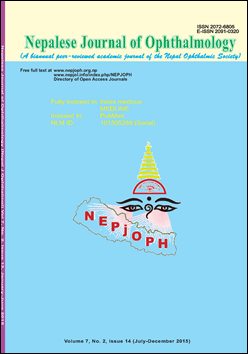Risk Factors Associated with Meibomian Gland Dysfunction: A Hospital Based Study
DOI:
https://doi.org/10.3126/nepjoph.v13i1.30605Keywords:
Meibomian gland dysfunction, Hypertension, Diabetes mellitus, Dyslipidemia, Post-menopausal status.Abstract
Introduction: Meibomian Gland Dysfunction (MGD) is a chronic diffuse abnormality of the Meibomian glands often found as a result of precipitating factors like dyslipidemia, infections, hypertension, diabetes, etc. This study aims to find the prevalence of various risk factors of Meibomian Gland Dysfunction (MGD) which will ultimately help in managing the disease and explaining the prognosis.
Materials and methods: A hospital based cross-sectional study. A total of 400 patients with MGD over the age of 30 were examined. Patients with a history of taking lipid altering drugs, pre-existing ocular comorbidities were excluded from the study.
Results: Severity of MGD increased with ageing. There was a significant risk of higher grades of MGD in hypertensives, diabetics & post-menopausal women. Higher levels of LDL cholesterol showed significant risk.
Conclusion: Blood sugar, blood pressure, blood cholesterol were seen to be the risk factors in the study and thus, should be kept within normal limits to reduce the severity of disease. Alcohol & cigarette consumption should be avoided even if they didn’t show a significant relationship.
Downloads
Downloads
Published
How to Cite
Issue
Section
License
This license enables reusers to copy and distribute the material in any medium or format in unadapted form only, for noncommercial purposes only, and only so long as attribution is given to the creator.




